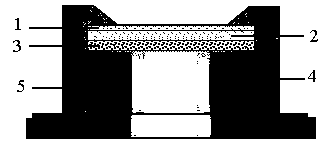Method for collecting free-state Pb (II) ions in environment quantitatively in situ
A quantitative acquisition, free state technology, used in color/spectral property measurement, sampling devices, etc.
- Summary
- Abstract
- Description
- Claims
- Application Information
AI Technical Summary
Problems solved by technology
Method used
Image
Examples
Embodiment 1
[0024] Mix 0.01 mol of 3-aminopropyltrimethoxysilane and 0.01 mol of glyoxylic acid in ethanol solution and react at a constant temperature of 50°C to form silanes containing Schiff base functional groups; then silanes containing Schiff base functional groups are mixed with Pb( ) ions to form a chelate, and heated at 120°C for 24 h in a hydrothermal way to make it fully react; mix ethyl orthosilicate with water in a certain proportion, adjust the pH to 2 with hydrochloric acid, and form a uniform solution, mix with Pb( ) ion chelate silane solution, stirred for 20 min, added ammonia water to adjust the pH value in the range of 6-8, and formed a gel. After aging for 48 h, the product was filtered, washed with ethanol first, and then dissolved in 1 mol / L hydrochloric acid After stirring and soaking in the solution for a certain period of time, Pb was removed ( ) ions, filtered, with NaHCO 3 The solution was washed to pH=7, and then the solid was washed with distilled water...
Embodiment 2
[0026] Mix 0.01 mol of 3-aminopropyltrimethoxysilane and 0.01 mol of glyoxylic acid in ethanol solution and react at a constant temperature of 50°C to form silanes containing Schiff base functional groups; then silanes containing Schiff base functional groups are mixed with Pb( ) ions to form a chelate, and heated at 120°C for 24 h in a hydrothermal way to make it fully react; mix ethyl orthosilicate with water in a certain proportion, adjust the pH to 2 with hydrochloric acid, and form a uniform solution, mix with Pb( ) ion chelate silane solution, stirred for 20 min, added ammonia water to adjust the pH value in the range of 6-8, and formed a gel. After aging for 48 h, the product was filtered, washed with ethanol first, and then dissolved in 1 mol / L hydrochloric acid After stirring and soaking in the solution for a certain period of time, Pb was removed ( ) ions, filtered, with NaHCO 3 The solution was washed to pH=7, and then the solid was washed with distilled water...
Embodiment 3
[0028] Mix 0.01 mol of 3-aminopropyltrimethoxysilane and 0.01 mol of glyoxylic acid in ethanol solution and react at a constant temperature of 50°C to form silanes containing Schiff base functional groups; then silanes containing Schiff base functional groups are mixed with Pb( ) ions to form a chelate, and heated at 120°C for 24 h in a hydrothermal way to make it fully react; mix ethyl orthosilicate with water in a certain proportion, adjust the pH to 2 with hydrochloric acid, and form a uniform solution, mix with Pb( ) ion chelate silane solution, stirred for 20 min, added ammonia water to adjust the pH value in the range of 6-8, and formed a gel. After aging for 48 h, the product was filtered, washed with ethanol first, and then dissolved in 1 mol / L hydrochloric acid After stirring and soaking in the solution for a certain period of time, Pb was removed ( ) ions, filtered, with NaHCO 3 The solution was washed to pH=7, and then the solid was washed with distilled water...
PUM
| Property | Measurement | Unit |
|---|---|---|
| Aperture | aaaaa | aaaaa |
| Granularity | aaaaa | aaaaa |
Abstract
Description
Claims
Application Information
 Login to View More
Login to View More - R&D
- Intellectual Property
- Life Sciences
- Materials
- Tech Scout
- Unparalleled Data Quality
- Higher Quality Content
- 60% Fewer Hallucinations
Browse by: Latest US Patents, China's latest patents, Technical Efficacy Thesaurus, Application Domain, Technology Topic, Popular Technical Reports.
© 2025 PatSnap. All rights reserved.Legal|Privacy policy|Modern Slavery Act Transparency Statement|Sitemap|About US| Contact US: help@patsnap.com

